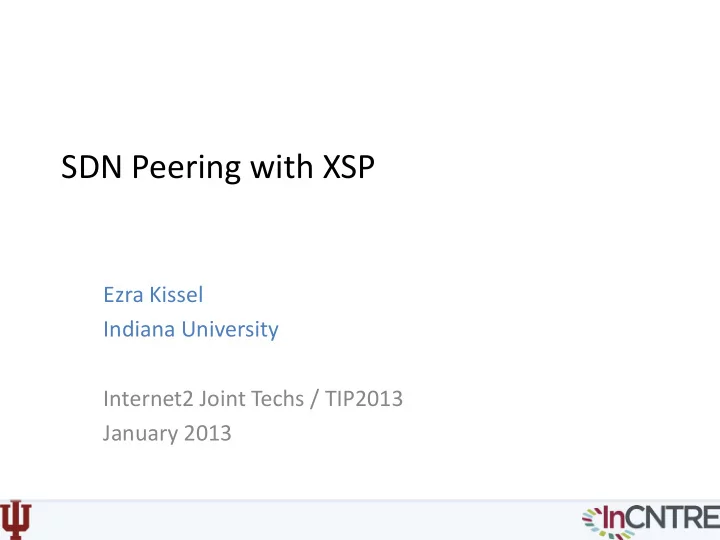

SDN Peering with XSP Ezra Kissel Indiana University Internet2 Joint Techs / TIP2013 January 2013
Overview • Software Defined Networking and OpenFlow – Fine-grained control of forwarding in the data plane – Tremendous interest in R&E as well as industry. • What exactly is SDN peering? • A few key characteristics: – Advertise and update topology of OpenFlow-based networks (most likely dynamic) – Provide a trust model (authentication and authorization) – Bridge existing inter-domain technologies • XSP and SDN: session-based protocol framework for interaction between applications and network services 1/15/2013 Internet2 Joint Techs / TIP2013 2
eXtensible Session Protocol (XSP) • In the spirit of the ITU-T Recommendation X.225 connection- oriented session protocol specification: – “ … a single protocol for the transfer of data and control information from one session entity to a peer session entity...” • XSP resides above the transport layer – Can encapsulate control and data PDUs into session layer PDUs • Provides a common set of features used by applications – Rather than being defined specifically for each application • We can also think of a session in the most literal sense: – “ a period of time devoted to a particular activity ” 1/15/2013 Internet2 Joint Techs / TIP2013 3
What is in a session layer? End-to-end state • Session state for parallel or serial transport connections – Context for mobility, multipath – Authorization and authentication • SSL/TLS, X.509, and SSH – Naming and addressing • Session connect() not tied to l3/l4 addresses – Explicit signaling and data channel • optimizations Phoebus WAN acceleration – Flexibility for new approaches and • technologies SDN – Delay tolerant flows for performance (buffer and burst) – 1/15/2013 Internet2 Joint Techs / TIP2013 4
XSP as a network configuration interface • Path framework – Modular service handlers for different technologies • A path is a set of applied rules in the network • API provides a consistent abstraction – Access to technology-specific fields if needed • Service called XSPd-SDN for SDN deployments 1/15/2013 Internet2 Joint Techs / TIP2013 5
XSP for application-driven networking Common interface for explicit path provisioning • – Interaction with OSCARS, OpenFlow, (e.g. Floodlight interface), Linux networking – Planned and/or in development: OESS and NSI Build end-to-end paths using XSP client API (wrapper, libxsp ) • Prototype deployment for DYNES • – GridFTP support via xio-xsp driver 1/15/2013 Internet2 Joint Techs / TIP2013 6
A case for SDN peering • Exchange dynamic campus and data center network topologies in a secure manner • XSP session provides for a period of authorized use – Secure context for exchanging credentials and updating peers • SDN also presents additional challenges – More complexity – Level of control offered – Is mutual economic incentive enough (i.e. BGP model)? • Allow for expressive policy 1/15/2013 Internet2 Joint Techs / TIP2013 7
Representing SDN flowspace Flowspace advertised as • a virtual network State can change as • devices are discovered or removed Use of the flowspace • network may also be updated between peers Track associated • controllers 1/15/2013 Internet2 Joint Techs / TIP2013 8
Unified Network Information Service • Topology and service information store • RESTful re-implementation of the perfSONAR protocols – Re-implementation vs. reworking based on experience and current thinking – JSON schema, BSON on the wire and storage for efficiency • Built-in AuthN/AuthZ using PKI – Attribute Based Access Control (ABAC) – UNIS.rReadOnly UNIS.rTrusted.rReadOnly (delegation) • Clients may also subscribe to network resources 1/15/2013 Internet2 Joint Techs / TIP2013 9
UNIS: towards a common network model HTTP/JSON RESTful UNIS SOAP/XML X MLRPC GENI AM API SOAP/XML TS GENI Internet2 TS Aggregates ESnet 1/15/2013 Internet2 Joint Techs / TIP2013 10
UNIS example Rule vlan: 601 nw_proto: 6 { Link … Port (in) Path Link Port (out) Rule . . . … hops 1/15/2013 Internet2 Joint Techs / TIP2013 11
Multi-domain SDN peering with XSP and UNIS • Sessions for negotiating authorized exchange of topology – Peering policy determines advertisement scope – Should distinguish between public and protected topologies 1/15/2013 Internet2 Joint Techs / TIP2013 12
What does this give us? • Framework for defining peering arrangements – Extensible and flexible – Consistent with existing XSP Path features • XSP abstraction enables both peer negotiation and exchange – Forwarding of advertisements – Valid over session lifetime • However, we may still require (per-domain): – Policy engine, path computation – Resource management, allocation – Additionally a network programming language abstraction 1/15/2013 Internet2 Joint Techs / TIP2013 13
Future work • Define peering policy in line with best practices • Demonstrate real world use-cases • OpenFlow islands bridged with WAN – Make use of existing WAN provisioning services • Trans-continental paths – TransPAC3, ACE, I2 100G 1/15/2013 Internet2 Joint Techs / TIP2013 14
Summary • XSP provides an interface for configuring advanced networks – SDNs including (but not limited to) those implemented with OpenFlow – “Network as a service” • XSP sessions provide a natural context for peering networks – Secure connections, negotiation of credentials – State over a period of time • UNIS gives us a consistent representation of the network – Campus, data center, WAN – Extensible schema with pub/sub and AuthN/AuthZ • Works with existing technologies 1/15/2013 Internet2 Joint Techs / TIP2013 15
Recommend
More recommend